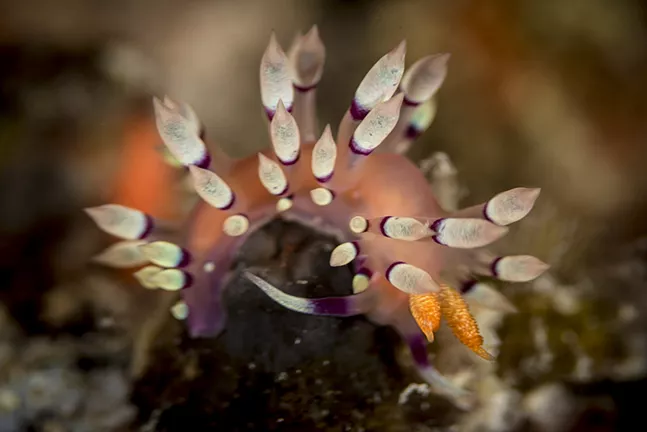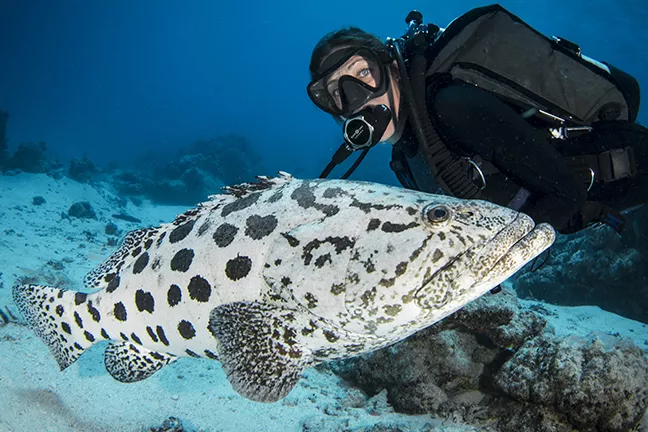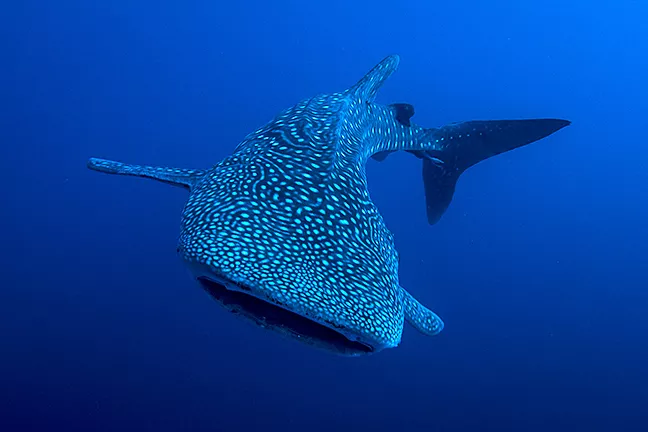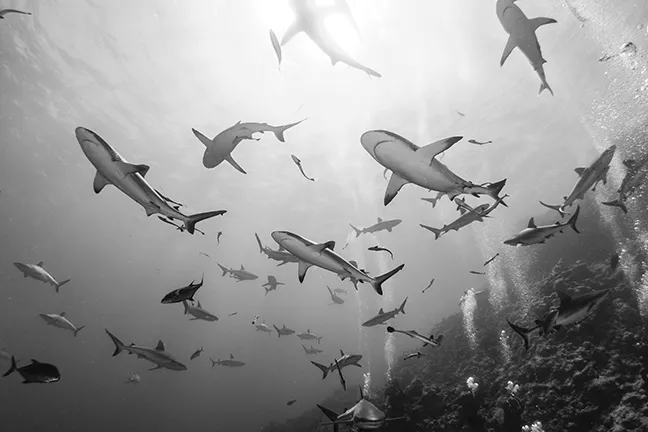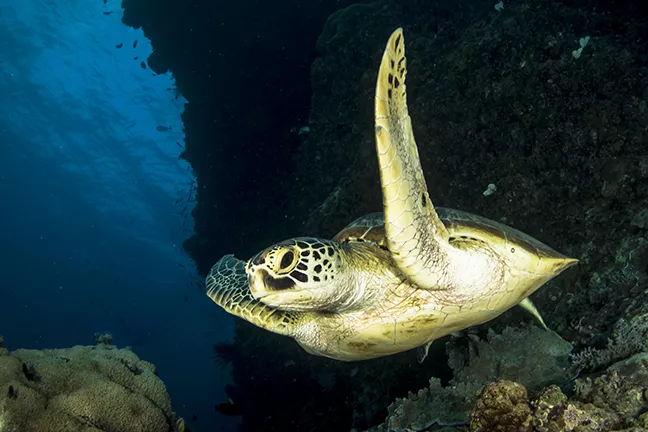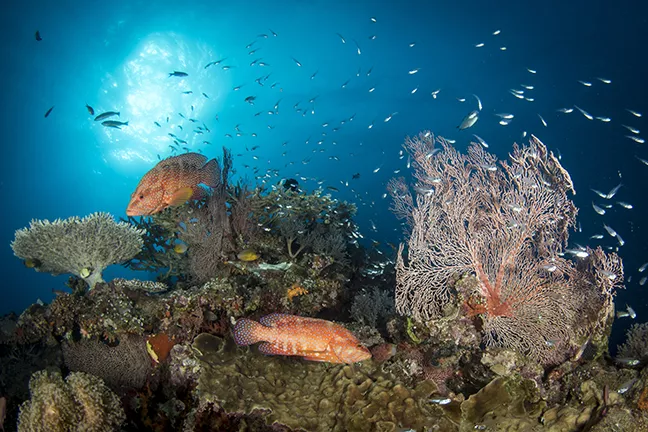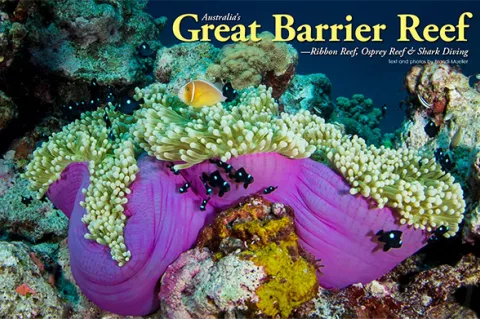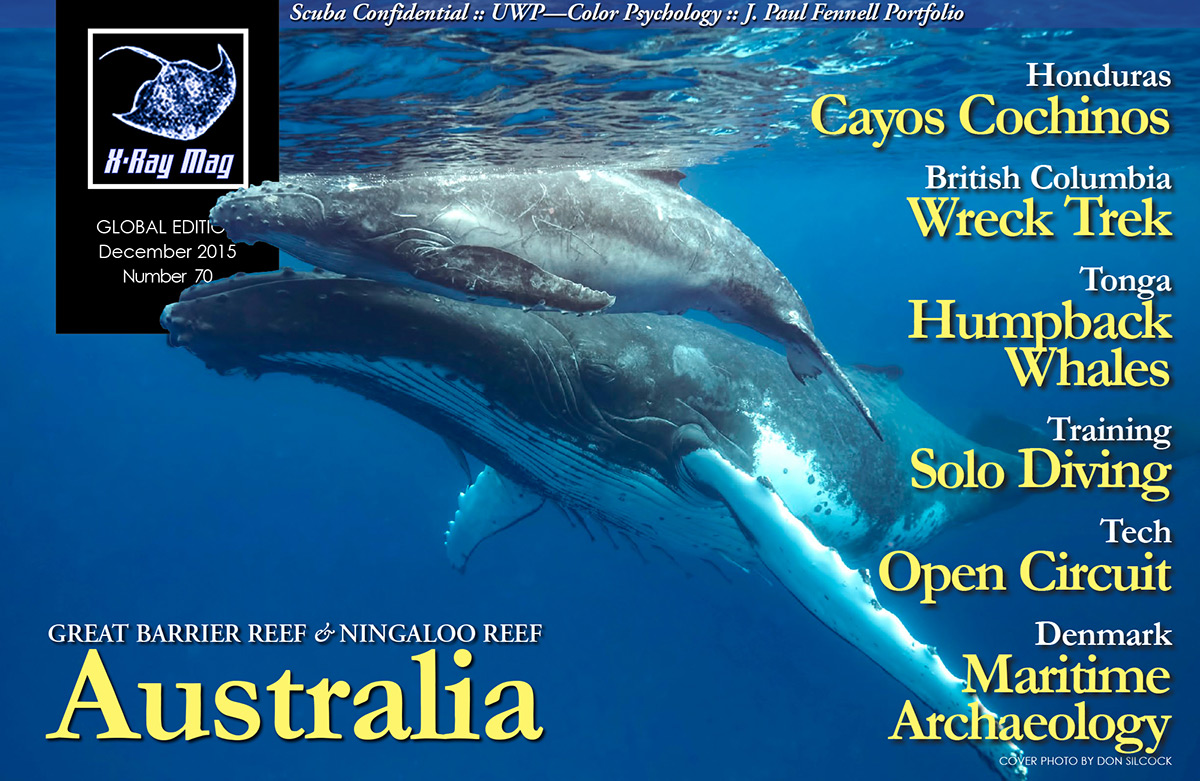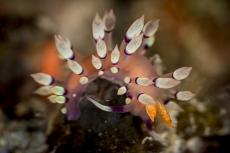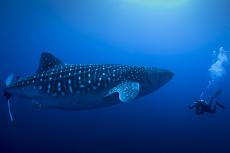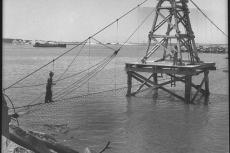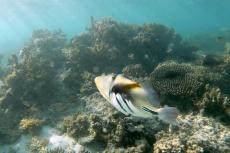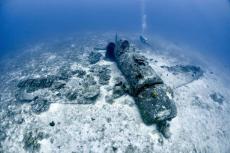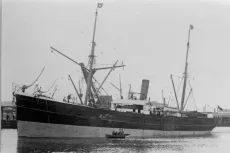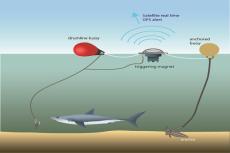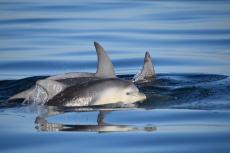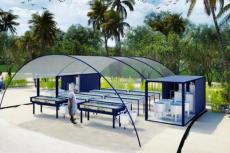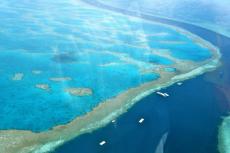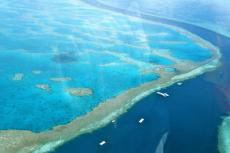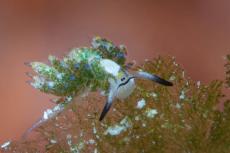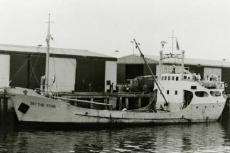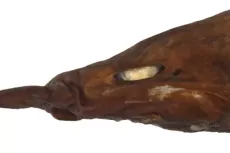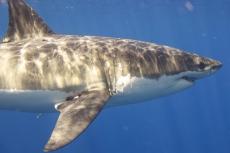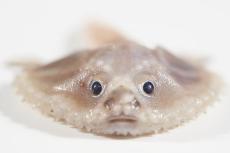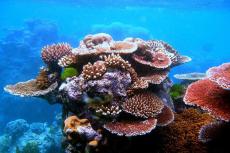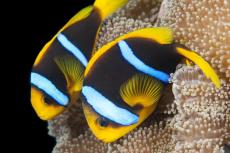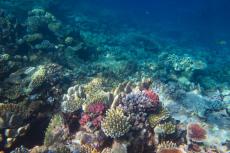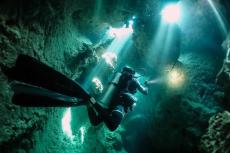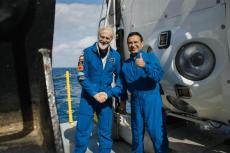If there was a place that inspired me to become a diver and invoked my passion and love for the ocean, it was Australia’s Great Barrier Reef (GBR). As a kid, I could spend hours watching television specials of this blue, fish-filled world that was so different from the Wisconsin farm town I grew up in.
Contributed by
Factfile
Brandi Mueller is a PADI IDC Staff Instructor and boat captain living in the Marshall Islands.
When she’s not teaching scuba or driving boats, she’s most happy traveling and being underwater with a camera.
For more information, visit: www.brandiunderwater.com.
While flying to Australia on my way to dive the GBR for a week with Mike Ball Dive Expeditions (MBDE), I was reading The Reef by Iain McCalman. The book was about the history of the GBR from its discovery (mostly at the demise of many famous sailor’s ships), Aboriginal connections and the people who survived by the reef (who have been living in the area for at least 40,000 years), and also research that has been done on the reef and its current state of health (not good overall, like most of the Earth’s reefs).
The book listed the GBR stats, which can easily be found through any Google search or Wikipedia. It is the largest coral reef system on Earth. You can see it from space. It is one of the seven natural wonders of the world, as well as a World Heritage Site. It covers over 344,000 square kilometers (133,000 sq. miles) and encompasses more than 900 islands. It is home to more than 1,500 fish species; 400 coral species; 500 types of seaweed and algae; 125 species of sharks and stingrays; 5,000 species of mollusk; 58 species of seahorses and pipefish; 30 species of whales, dolphins and porpoises; as well as turtles, dugongs and saltwater crocodiles.
Whew, those are some pretty awesome stats.
And I get to spend a week diving it. Jealous? You should be.
Iain McCalman quotes British geologist Joseph Jukes, in The Reef. While serving as a naturalist on a GBR exploration expedition in the mid-1800s, Jukes said, “What an inconceivable amount of animal life must be here scattered over the bottom of the sea, to say nothing of moving through its waters, and this through spaces of hundreds of miles. Every corner and crevice, every point occupied by living beings, which, as they become more minute, increase in tenfold abundance.” I was looking forward to see for myself what was “moving through its waters.”
Finally arriving in Cairns, I collected my luggage and headed down towards the harbor to the MBDE office. With a few hours to myself before it was time to board the boat, I wandered down the Esplanade at the water’s edge, eager to meet my shipmates and start diving.
Day 1: Ribbon Reef #10
We left Cairns shortly after boarding and headed north overnight. I would like to say the soft and gentle sway of the boat rocked us to sleep, but in reality it actually knocked a few of us out of our beds. August is winter in the Southern Hemisphere, and wind and waves are common. Thankfully, sunshine greeted us in the morning at Ribbon Reef #10 for our first dive at Goggle Gardens.
Goggle Gardens. An easy dive, it was great for orientation and getting back into the swing of things. We found pretty coral formations and plenty of fish. A few whitetip reef sharks were hanging out in the sand below us as we slowly made our way around the gardens, taking in all the marine life around us.
Cod Hole. Up next was one of the GBR’s most famous dive sites, Cod Hole, known for its friendly potato cods. These charismatic (and large) fish either swarm divers or act completely indifferent as divers get up close and personal to take photos. Three large cods were right under the boat when we jumped in and they happily posed for our many cameras. They even allowed us to snap photos of them with their mouths wide open while being cleaned by tiny cleaner wrasse.
Gotham City. Our fifth and last dive of the day was a night dive at Gotham City. It turned out to be one of the few night dives of my life where I wished I had a wide-angle lens on. You might think fish aren’t very smart, but the jacks around Ribbon Reef #10 have learned to follow night divers. Like a pack of hungry dogs, they follow divers, and as soon as someone stops to look at an unsuspecting sleeping fish, the jacks dart in and gobble up the resting fish. Although we tried hard not to expose the jacks’ potential prey to this danger, the jacks nevertheless managed to snatch away a few more such "snacks" for dinner before the divers returned to the surface.
After the last dive, the captain started the engines and, over the course of the night (another bumpy one), took us to Osprey Reef, 348km (216 miles) northeast of Cairns.
Day 2: Osprey Reef
Osprey Reef is a submerged atoll with sheer walls descending 2,000 meters (6,500ft). It is known for its great visibility and an abundance of pelagic marine life.
Fairy Grotto. We started our dive at a beautiful site named Fairy Grotto. Getting into the water before breakfast, the sun was still low in the sky and bright rays of yellow light shone through the water onto the reef. We swam into a light current along the edge of the wall, looking out into the blue for sharks that often swim by. Along the wall, fish swam sideways and looking down on them, it almost felt as if we were flying.
Admiralty Anchor. Our second dive site was at Admiralty Anchor, which was also a wall dive; at the top of the wall were lots of little swim-throughs and interesting rock and coral topography, making the dive site seem like a fun maze. So named because of an anchor that could be seen at the end of one of the swim-throughs, we saw plenty of fish and a turtle.
False Entrance. Our last dive site of the day was False Entrance, which had a beautiful sheer wall the boat moored at the edge of. Right under the boat was a large school of trevally; while photographing them, a huge bumphead parrotfish swam by. I cruised the wall for a little while as grey reef sharks, including several babies, swam up and down the wall. I headed back into the shallow reef area to try and find a school of barracuda the dive guides said were often there.
Unsuccessful in my barracuda hunt, I headed back to the boat but decided to take one more look off the edge of the wall. In the distance, I saw a shadow. A large shadow. My heart rate accelerated as the shadow got larger and closer till it was moving directly toward me. I had to actually tell myself to calm down and get the camera ready (and pinch myself to see if it was really happening). The shadow morphed into a huge whale shark that swam directly over me. It then turned in a circle and came back towards me, turned again, and then continued on. I was about to pinch myself again (just to check) as another diver showed up at the perfect time for me to get a shot with him and the whale shark.
The whale shark was the talk of the boat for the rest of the day. I find one of the most amazing things about diving is seeing the unexpected in situations like this. There are some places you can go where it’s almost guaranteed you can see whale sharks, either seasonally or because they are being fed. But when you think of how large the Coral Sea is and how little time we spent underwater there, what are the odds of such a rare creature to just happen to swim by at just that moment on the edge of that exact part of the wall? I found it breath-taking.
Day 3: Shark diving
After the whale shark, I sort of felt like they might as well take me home, nothing was going to top that experience, but we still had one more day at the amazing Osprey Reef.
North Horn. Our morning dives were at North Horn, where I was lucky enough to do a shark dive. Shark feeding is of course controversial, but MBDE and the one or two other operations that dive Osprey Reef have been bringing sharks closer to divers at North Horn for many years.
When the boat pulled up, so did the sharks. They have been conditioned to know when they are going to be fed. With only two liveaboard boats feeding the sharks less than once a week, this site isn’t “over-fed.” The sharks did not seem overly aggressive and had absolutely no interest in the divers, only the container with food in it. Divers remained on the wall, staying stationary by holding on to rocky areas of the wall where there wasn’t any coral. A bucket of food was on what almost looked like a rock dinner table and the sharks circled the area until the bucket was opened, they ate their food, and then they left.
Shark dives allow divers to have close encounters with sharks and to be able to observe for themselves that sharks are not the aggressive, man-eating predators depicted in the movies (nor do they fall from tornados). Dives like this can help change the negative image of sharks through the divers sharing their stories and photos with others. They can help spread awareness and educate those who don’t get to see sharks personally, and I’m a believer that shark dives done safely for both the sharks and divers help to promote a positive image of sharks to the non-diving population.
That being said, this dive was awesome. Between 40 and 50 grey and whitetip reef sharks showed up and put on a fantastic show by coming close to divers and even staying around swimming along the wall after the food was released.
Half Way. Our last two dives at Osprey Reef were at Half Way. This pretty dive site was another with lots of pathways and maze-like passages through the reef. I found four anemones of completely different colors, including a vibrant purple anemone just under the boat.
After the dives, it was time for the Farewell BBQ party for several of the guests who were only on a four-day trip. MBED offers three-, four- and seven-day trips. Those signing up for three- and four-day trips either end or start the trip at Lizard Island where they take a low-altitude scenic flight to or from Cairns. Overnight, the captain took us back west to the Great Barrier Reef and Lizard Island.
Day 4: Lizard Island
Before dawn, we arrived at Lizard Island and said goodbye to several of our new dive buddies. A few of us staying for the whole seven days went to shore with them to say one last goodbye and have a short tour of the island with our photo and video pro, Julia. Now a National Park, this island was a sacred place for the aborigines and also was visited by Captain Cook (he saw a lot of lizards and decided to name it after them). It currently hosts a research station and a resort.
New guests arrived on the plane and as we got to know them, the boat headed back to Cod Hole for another dive with those crazy cod fish. After that, we moved to a site called the Snake Pit. Who can guess what we saw there?
Snake Pit. Did I mention the GBR has 17 species of sea snakes? (Eek!) Quite a few olive sea snakes reside at the Snake Pit and, according to my internet searches, they are considered aggressive and highly venomous (this is Australia, what else would you expect?) But they are not aggressive towards divers and showed no interest in us whatsoever.
Actually, there was no time to be afraid of them because, just under the boat, we found them mating! Three snakes were curling around each other. One of them, I’m going to assume was the female, kept trying to swim away, but the other two would catch up and wrap themselves around her. Several others were seen going up and down from the surface (they need to breathe about every 20 minutes).
On the night dive, I forgot all about the sea snakes and was entranced by mini coral walls covered in nudibranchs and flatworms.
Day 5: Lighthouse Bommie
On the morning of our fifth day of diving, we went to Lighthouse Bommie. Somehow, I ended up the first person in the water; just below the surface was pure beauty. At least three different schools of fish were feeding in the water column and it looked like it was raining fish. The water was deep blue, with little dark shadows darting around everywhere. The bommie was a coral pinnacle that started around 30m (100ft) and went up to 3m (15ft) from the surface.
Swimming down to the sand, a large school of snappers with yellow stripes blocked my view of a green sea turtle waking up and heading towards the surface. After taking a few breaths of air, the turtle came back down on the pinnacle and swam into a little crevasse where cleaner fish came out and gave the turtle a scrub. For the rest of the dive, the turtle hovered effortlessly as tiny cleaner fish picked at him (and we took dozens of photos).
Pixie Pinnacle. If you could imagine what a dive site called Pixie Pinnacle looked like, I bet you would conjure up images of tiny, prettily-colored fish darting around. If that’s what you imagined, you’d be right, and our second and third dives took place there. I hadn’t put my macro lens on my camera for any day-dives yet (I might have missed the whale shark), but the dive guides told me this was a great site for nudibranchs, anthias, anemonefish and more, so I shifted into macro mode. In typical photographer humor, as I was attaching my 105mm lens, I told those around me they were probably going to see a whale.
But that is never really supposed to happen, right? This is just a joke we make... right?
Well. About 40 minutes into the dive, one of the dive guides came up to me and pointed at a few divers, pointed to his eye, and then gave the signal I thought was for dolphins (hand doing a large, slow wave motion). I laughed a little to myself, “It figures,” but hey, it was just dolphins, right? They probably just swam quickly by and I was quite content with some really cool nudibranchs I was shooting. I did a nice, long, 70-minute dive and headed back to the boat. Upon arriving, I noticed some people were snorkeling behind the boat, so I looked out into the blue… and a minke whale swam by!
Suddenly, my nudibranchs weren’t that cool, and I literally flew out of the water and changed my camera lens at Mach speed. Jumping back into the water on a snorkel, I joined the others behind the boat, and a few minutes later, a minke whale swam right under me.
Minke whales (dwarf minke whales, to be exact) have quite the reputation with MBDE. In June and July, they pass through the GBR and these friendly whales seem to enjoy being around the Spoilsport just as much as divers do. In-water snorkeling encounters often last for hours. But it was mid-August, long after the minkes are supposed to be gone, and it turned out to be one of the latest recorded minke encounters ever recorded. Someone on the boat must have been a good luck charm.
Day 6: Steve’s Bommie
Our final day of diving started out at Steve’s Bommie—another pinnacle, which was also loaded with fish. Thousands of purple, pink and orange anthias swarmed around the top of the bommie, and at the very top, there was an anemone with Nemo—an Ocellaris clownfish. (You can’t dive on the GBR and not find Nemo!) The rest of the trip, we had only seen anemonefish, but this was the first actual Ocellaris clownfish sighting we had all week.
The last two dives were at a new reef the crew wanted to check out. This exploratory dive turned out to be really pretty and a perfect, relaxing site to end our week of diving.
With our gear cleaned, cameras put away, and packing started, we had another Farewell Aussie BBQ that included our captain playing guitar and singing while we ate shrimp right off the ‘barbie’ and later had another fantastic dinner onboard. Overnight, we headed back to Cairns under a clear sky and a million stars.
Mike Ball
You cannot take part in a Mike Ball Dive Expeditions without Mike.
Upon arriving in Cairns, I was amazed to find Mike Ball at the office greeting me and the other guests as we checked in, and he made plans to meet us for dinner at a nearby restaurant. He has been running liveaboard dive boats for over 35 years (diving operations since 1969) and still makes an effort to meet every guest. His passion for the ocean and his business is undeniable, as he talks openly about his career, the upcoming dive expedition, answers questions, and is generally just really interesting to talk to. You don’t expect to be having dinner with the owner before starting your trip (especially when that owner is the legendary Mike Ball and an inductee of the International Diving Hall of Fame).
Going home
It is taboo to call a week on the Spoilsport a “dive trip”, it is more accurately called an “expedition”; its definition would be “a journey or voyage undertaken by a group of people with a particular purpose.” Mike Ball trips are just that: a group of people sharing the desire to dive on little-dived reefs, to see the amazing and beautiful and unexpected wonder of the ocean, and to become (for a little while) a part of the Earth’s largest living thing. I left feeling I’d experienced something extraordinary, and if you have the opportunity to partake in a voyage with Mike Ball Dive Expeditions, you will too. ■

